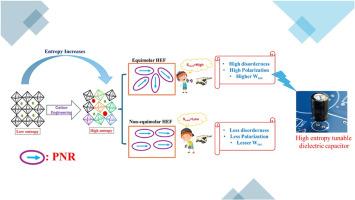Compositional engineering of A-site high-entropy ferroelectrics using equimolar and non-equimolar methods
IF 3.5
3区 化学
Q2 CHEMISTRY, INORGANIC & NUCLEAR
引用次数: 0
Abstract
This study resolves the ambiguity regarding the suitability of equimolar and non-equimolar high-entropy ferroelectrics (HEFs) for diverse industrial applications. HEFs show great promise as lead-free ceramic materials for improving pulse power device efficiency, enhancing energy density, and boosting overall performance. HEF ceramics, specifically [(Na (0.5) K0.5)0.5(Bi0.5Eu0.5)0.5] (1-x) SrxTiO3 (x = 0.2, 0.3, 0.4), are synthesized using a solid-state technique with both equimolar and non-equimolar compositions. Structural analysis confirms their single-phase perovskite cubic structure, further supported by tolerance factor calculations. Surface morphology analysis reveals well-packed grains with minimal porosity, while strontium (Sr) promotes grain growth, resulting in larger grain sizes with increasing Sr content. A maximum dielectric constant of ∼1855 was observed at 1 kHz, exhibiting frequency dispersion at x = 0.3. The highest recoverable energy storage density (ESD) achieves 0.68 J/cm3 at x = 0.2 in an electric field of 122.5 kV/cm, with an efficiency of 40 %. Equimolar compositions demonstrate superior energy storage performance due to higher configurational entropy. For Sr0.2, scaling analysis reveals three distinct regions, with the recoverable energy density (Wrec) increasing alongside the employed electric field, highlighting the material's energy storage potential. Additionally, the maximum power density (Pdmax) is calculated as 10 MW/cm3 for Sr0.2. This study underscores the advantages of equimolar HEF compositions in tuning dielectric and ferroelectric properties for advanced energy storage applications.

a位高熵铁电体的等摩尔和非等摩尔组成工程
这项研究解决了关于等摩尔和非等摩尔高熵铁电体(hef)在各种工业应用中的适用性的模糊性。hef作为无铅陶瓷材料,在提高脉冲功率器件效率、增强能量密度和提高整体性能方面具有广阔的前景。HEF陶瓷,特别是[(Na (0.5) K0.5)0.5(Bi0.5Eu0.5)0.5] (1-x) SrxTiO3 (x = 0.2, 0.3, 0.4),采用固态技术合成具有等摩尔和非等摩尔成分。结构分析证实了它们的单相钙钛矿立方结构,并得到容差系数计算的进一步支持。表面形貌分析表明,锶(Sr)有利于晶粒的生长,随着锶含量的增加,晶粒尺寸增大。在1khz处观察到的最大介电常数为~ 1855,在x = 0.3处表现出频率色散。在122.5 kV/cm的电场下,当x = 0.2时,最高可回收储能密度(ESD)达到0.68 J/cm3,效率为40%。等摩尔组合物由于具有较高的构型熵而表现出优异的储能性能。对于Sr0.2,尺度分析揭示了三个不同的区域,可回收能量密度(Wrec)随着电场的增加而增加,突出了材料的能量存储潜力。此外,Sr0.2的最大功率密度(Pdmax)计算为10 MW/cm3。这项研究强调了等摩尔HEF成分在调节介质和铁电性能方面的优势,以用于先进的储能应用。
本文章由计算机程序翻译,如有差异,请以英文原文为准。
求助全文
约1分钟内获得全文
求助全文
来源期刊

Journal of Solid State Chemistry
化学-无机化学与核化学
CiteScore
6.00
自引率
9.10%
发文量
848
审稿时长
25 days
期刊介绍:
Covering major developments in the field of solid state chemistry and related areas such as ceramics and amorphous materials, the Journal of Solid State Chemistry features studies of chemical, structural, thermodynamic, electronic, magnetic, and optical properties and processes in solids.
 求助内容:
求助内容: 应助结果提醒方式:
应助结果提醒方式:


